#ttrpg mechanics
Text
Daggerheart Character Build thoughts!
I am actually out at work and haven't checked the version that's since come out, but I did participate in the character build beta, and the NDA is officially lifted, so here's my thoughts from that! It's definitely limited since I just made a L1 character and didn't go through gameplay, though I surmise about some aspects of gameplay.
Overall, it clearly seems to be made by people who love a lot of things about D&D 5e but wanted both more flexibility and more simplicity, which is difficult. I think they succeed.
To that end, it takes away some of the crunchier aspects (precise positioning, exact amounts of gold) and I think for some people that will be a problem, and that's valid, but ultimately this game wants to both allow for interesting mechanics in and out of combat while also not being terribly math/map/resource management heavy. It is a hard line to walk; most systems either go hard crunch or go entirely gooey.
The dice mechanic (2d12, Hope and Fear system) is fantastic; look it up but I think it handles mixed successes more gracefully and interestingly than a lot of games.
The playtest was not super clear on armor and evasion choices (or indeed what evasion means; it seems to be sort of initiative but sort of dex save, or maybe more like the Pathfinder/old school D&D varying ACs by scenario?). It was much, MUCH clearer than D&D on weapon choices (part of why I play casters? Weapon rules in D&D are annoying and poorly explained and many people rightfully ignore them) so I'm hoping this becomes clear when there's a full guide rather than just the character creation info.
The character creation questions by class were fantastic and in general, and this is a theme, this feels like it guides people towards collaboration. FWIW I feel like D&D has that information, but the way it's presented is very much as flavor text rather than a thing you should be doing. Daggerheart makes this a much more core part of creation. The Experience mechanic is particularly clear: you better be working with your GM and really thinking about background, rather than slapping it on as a mechanic.
The other side of character creation questions is that it really encourages engagement with the class, which is something I've talked about. I think either subversion for the sake of subversion, or picking a class for the mechanics and aesthetic but not the fundamental concept, will be much harder to justify in Daggerheart, and I think that's a good thing because when people do that, their characters tend to be weaker.
The downtime is designed for you to write hurt/comfort fanfic about and this is a compliment. There are a number of mechanics that reward RP, particularly one of the healing mechanics under the Splendor track. I feel like a weakness of D&D is that when you try to reward RP it's really nebulous because there's not actually a ton of space to put that - you can give inspiration, but, for example, the empathy domain Matt homebrewed actually feels kind of off because it's based on such fuzzy concepts amid mechanics that are usually more rigid. Daggerheart comes off as much cleaner yet still RP-focused, and I'm excited to see it in action.
A judgement of Candela and I suppose Daggerheart might be that it's designed for actual play. I've mentioned before that I know people who are super into the crunch and combat and numbers of TTRPGs and are less story-oriented, and again, that's valid, but actual play is just storytelling using a ttrpg and so yes, a game that encourages RP while also having mechanics to support that and influence it is an extremely good goal. I am not an actual player, but I do like D&D games with a good plot and not just Go Kill Monsters, and I want to play this. (I also have some real salty thoughts about how if you modify an existing game for AP purposes that's staggering genius apparently, but if you make your own game how dare you but that's another post).
And now, the classes/subclasses. I am going to sort of use D&D language to describe them because that's a point of reference most people reading this will understand, but they are not one-to-one. A couple notes: everyone can use weapons and armor. HP is not totally clear to me but it seems to be threshold based - everyone has the same HP to start but people have different thresholds and armor, so the tank classes have the same amount of HP but are much harder to actually do damage to.
All classes are built on a combination of a subclass and two domains. There are 9 classes and 9 domains. This technically means that if you wanted to fuck around and homebrew you could make up to 36 classes (27 additional) by just grabbing two domains that weren't otherwise combined, which is fun to consider for the potential. Anyway I cover the classes and briefly describe domains within them. You can take any domain card within your domain, regardless of subclass.
There are six stats. Presence, Instinct, Knowledge, and Strength map roughly to Charisma, Wisdom, Intelligence, and Strength. Dex is split into Agility and Finesse; Agility covers gross motor skills (jumping, most ranged weapons, "maneuvering") and Finesse finer ones (lockpicking and tinkering, though also it does cover hiding). The really big wins are first, no CON score, so you don't need to sink stat points into something that grants no skills but keeps you alive. The second one is that the "hybrid" classes spellcast from their physical stat. This is fucking fantastic. The thing about ranger or paladin or the spellcasting subclasses of rogue and fighter in D&D is that if you don't roll pretty well you're locked into the core stats and CON and nothing else. (This also doesn't have rolling for stats: you assign +2 to one stat, presumably your main, and then distribute two +1s, two 0s, and one -1.)
Your HP, Evasion, and Thresholds are set by class, and there's a core ability; the rest is all from the cards you take for subclass and domain.
Leveling up is very much based on taking more domain cards (abilities) but has a certain degree of flexibility. It's by chunks: in leveling up anywhere levels 2-4, you can, for example, increase your proficiency by +1 once, so if you wanted to do that at level 2 but your fellow player wanted to wait until level 4 and take something else at level 2 instead, they could. It allows for more min-maxing, but also everyone has the same level up rules and differs only in the abilities on the cards, which is very cool.
Bard: Grace (enchantment spells) and Codex (learned spellcaster stuff; the spells available are definitely arcane in vibes) based, Presence is your main stat. The two subclasses map roughly to lore-style stuff and eloquence. Core class ability is sort of like inspiration but not entirely. It's a bard; I like bards a lot, and this is very similar vibes-wise to your D&D bards. If you like D&D bards you will like this.
Druid: Sage (nature spells) and Arcana (raw magical power spellcaster stuff), Instinct is your spellcasting/main stat. The two subclasses are elemental but frankly cooler than circle of the moon, and a more healing/tranquility of nature focused one. I really think Marisha probably gave feedback on this one, because the elemental version is really strong. You do get beastform; it is quite similar to a D&D druid under a different system, as the bard, but the beastform options are, frankly, better and easier to understand.
Guardian: Valor (melee tank/damager) and Blade (damage). Strength based for the most part (Valor mechanics assume strength) though you could go for like, +2 Agility +1 Strength to start. This is barbarian but like. 20 times better. It is, fundamentally, a tank class, and it is very good at it, with one even more tank-focused subclass and one that is more about retaliatory damage. You do have a damage-halving ability once per day, but really guardian's questions are incredible. I think Travis and Ashley likely gave feedback. Also rage doesn't render you incapable of concentration as that doesn't seem to be a thing, so multiclassing seems way more possible (you are, I think, only allowed to do one multiclass, and not until you reach level 5 minimum, which I am in favor of). Yes, you can be a Bardian.
Ranger: This is what I built! It is based on Sage and Bone (movement around the field/dodging stuff) and it is Agility-based, including for spellcasting, which is a MASSIVE help (as is, again, the fact that CON isn't a thing.) The subclasses are basically being really good at navigation, or animal companion. Most importantly to me you can be a ranger with a longsword and you are not penalized; Bone works with either ranged weapons or melee.
Rogue: Midnight (stealth/disguise/assassination spells and skills) and Grace-based. Yes, rogue is by default a spellcaster, which does help a LOT with the vibes for me. One subclass is basically about having lots of connections (as a spy or criminal might) and the other is about magical slinking about. Hiding/sneak attack are also streamlined. I will admit I'm still more interested in…almost everything else, but I think it evened out a lot of rogue weaknesses.
Seraph: Splendor (healing/divine magic) and Valor. This is your Paladin equivalent. It is strength-based for casting, again making hybrid classes way less stressful. Questions for this area also incredible; you do have something not unlike a lay on hands pool as well. Your subclasses are being able to fly and do extra damage; or being able to make your melee weapon do ranged attacks and also some extra healing stuff, the latter of which is my favorite. Yasha vibes from this, honestly. Single downside is this is the only class where they recommend you dump Knowledge. I will not, and I never will. Now that I don't have to make sure CON is high? I am for REAL never giving myself less than a +1 Knowledge in this game.
Sorcerer: Arcana (raw nature of magic/elemental vibes) and Midnight based. Yes, sorcerers and rogues now share a vibe, for your convenient….less enthused feelings. Instinct-based, which intrigues me, and the core features are in fact really good. The two subclasses are either one that focuses on metamagic abilities, or one that is elemental based. I would play this for a long-running game, though it's not my favorite, and I can't say that for D&D sorcerer (except divine soul).
Warrior: Blade and Bone, and the recommended build is Agility but you could do a strength build. Fighter! One subclass is about doing damage and one is about the hope/fear mechanics core to the game that I have NOT talked much about. I will admit, the hybrid martials and Guardian are more interesting to me but you do have good battle knowledge.
Wizard: Codex and Splendor. Wizards can heal in this system; farewell, I will be doing nothing else (jk). Knowledge-based, and you can either go hardcore expertise in knowledge, or be a battle wizard.
Other scattered thoughts: healing is not as big a deal here; there is no pure cleric class! There is also no monk, warlock, or artificer. There is not a way to do monk as a weaponless class really though you might be able to flavor the glowing rings as a monk weapon and play a warrior. Wizard, meanwhile, with the right experiences and high finesse, would allow for some artificer flavor. Cleric and Warlock are the two tough ones and I will admit those are tricky; I feel like you'd have to multiclass (which you cannot do until level 5) between perhaps seraph and a caster class and you're still going to come off very paladin.
395 notes
·
View notes
Text
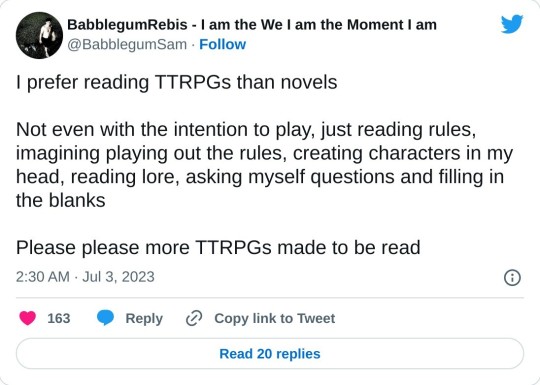
Been thinking about this & putting it into practice when writing The Perilous Pear & Plum Pies of Pudwick for a while: thanks to the ever excellent @babblegumsam (who you are probably already following and if not now is your chance to rectify that) for the final straw that made me write this up today. I truly believe if you have any interest in TTRPGs, play, or design you'll get something out of it, it's a further 5.4 mins read from here on out.
--------------------
Play is interaction.
Reading is interaction.
Below I will argue the necessity & usefulness of thinking the relationship between reading & play in TTRPGs as (almost) the exact same thing to unlock a wide & deep potential as reader/player/designer.
--------------------
Reading & play don't have to be the same thing. But you can't play without reading (in the sense of reading representations, images, ideas, concepts, interactions, etc, not just written text), because then there could be no interaction.
Reading and play can both accurately describe a given act or process. For instance: I read a table or piece of prose in a TTRPG book.
I say this because this is an idea that people struggle with, and while I encourage debate around the concept, we first have to agree on some basic building blocks that I hope I'm able to communicate here. For instance, there exists a potential reality in which tabletop roleplaying games are called tabletop reading games and nothing else about them changes (except for the consequential ability to think of reading in ttrpgs as play, and the potential this tool unlocks), because the prerequisite role for all other roles being played in a role-playing game is that of the reader.
This is true for much more than TTRPGs, but if we simply focus on acknowledging that reading & play in ttrpgs can and often are the same thing, then we are able to make informed design choices on this basis that we otherwise lack the agency to make – and which are nonetheless choices that are being made while we miss the opportunity to observe, read & ultimately interact and/or change and/or play with them.
To not think of the relationship between reading & play in TTRPGs in this way is to limit your agency as a designer, reader, player, and ultimately to cause yourself to be unable to synthesise these roles which are deeply inter-related, perhaps more so than they are disparate.
However you define it, Good Design necessitates the application of the right tool for the job. This requires making, maintaining & improving the tools that you have access to. The reader/player relationship is not only one of these, but an integral one that precedes a great many (if not all) of the other tools that you can & do employ as designer/player/reader.
If you allow this tool to remain blunt and imprecise (and especially if you don't acknowledge that it exists and that you use it in every choice you make), what you are doing is making a choice to blunt all of your other tools, even if you aren't aware of it.
This is poor design, poor play, and poor reading,* and I believe that this is true regardless of how you define each of those terms.
*though of course we could - and I think should - argue over the semantics & limitations of my imprecise use of the word "poor" there and the further ideas it smuggles in unacknowledged, but I trust that you will be able to infer what I'm trying to communicate in my use of it and I further hope that by leaving this imprecise application of a tool here in the way that I have used it, it might serve as a good example of the consequences, limitations & potential dangers of applying tools/terms/ideas that might be best described as "too blunt for the job", which is the very thing I'm attempting to highlight & address here.
It would not seem very sensible to choose to limit yourself in this way unless it allowed you access to new tools, which is a choice that you could only make once you are familiar with the central idea I'm presenting here – in other words, if you break the rules without understanding them you are very unlikely to be taking a step forward and much more likely to just be shuffling in place or even stepping backwards.
I hope that this short interaction has unlocked or reinforced your access to a useful tool that will allow you to sharpen your understanding of the play/reading relationship in TTRPGs and in turn refine & maintain your existing tools and your ability to synthesise new ones.
I look forward to discovering with you what new agencies this allows us to unlock, and I hope you take what you have read here and play with it to design new realities that you & I have yet to imagine.
#reading#play#ttrpg#indie ttrpg#ttrpg design#indie ttrpg design#tabletop roleplaying#games#game design#design theory#theory#design blog#ttrpg blog#ttrpg ideas#ttrpg resources#ttrpg mechanics#ttrpg dev#indie ttrpg dev#rpg design#ttrpgs for everyone#dialectics#communication design#communication theory#design philosophy#ttrpg community#ttrpg family#《 not a fan of that as a tool btw it is incredibly limiting and we could all do without it. why not be more precise & why not start now#any other useful tags you can think to add please do so. i think this deserves to reach far and wide & is very useful if i do say so myself!#Finally: take it and run with it. play/change/sharpen/blunt this tool. it's yours. make it your own (or dont). dont do what i say (or do) 🤡#respect & solidarity and thanks for reading. I hope you have found value in my contribution 🤝
263 notes
·
View notes
Note
TTRPG ask game: 🌠 (mechanic u love)
I love mechanics that have you interact with or change materials, like how you light a match and maybe light paper on fire in Caro Asercion's 'The Incendiaries': https://seaexcursion.itch.io/the-incendiaries
Thanks for the ask!
23 notes
·
View notes
Text
Tales from the Aether: Monster Design
Part 1 - pre play testing
So I've got a bit of energy and inspiration from a previous post so I'll give a quick run down of how monsters work in this system.
Monsters in this system have a total of 10 Levels and are broken into 5 Ranks within each Level: Minion, Grunt, Boss, Spawn, and Swarm. Level 1 creatures are balanced around a party of level 1-3 adventurers. Level 2 creatures are balanced around level 3-6 adventurers, so on and so forth. However, I will go in depth on different kinds of encounter design based on the party's composition and give GM's the tools to tweak a monster's Level or Rank as needed.
All Monsters of each Rank, regardless of Level, share similar surface level characteristics, allowing them to be scaled to player levels easily. A Level 10 Minion servers the same purpose in an encounter as a Level 1 Minion. How to create your own monsters is clearly laid out with templates and damage ranges, stat ranges, and health ranges compared to various party levels.
Additionally, a significant focus is put on every monster's gimmick and motivations. Every monster has a unique ability or special circumstances where they thrive such as favoring dark environments to gain additional Defense and Ambush capabilities. Every creature also has a number of points distributed between the following motivations: protection, hunger, greed, survival, and blood lust. This will help guide the GM in determining how the monsters act in and out of combat and is easily adjustable for every monster.
Lastly, every monster has damage vulnerabilities and weak spots the players can exploit during combat. This encourages the players to seek out information about their potential enemies as well as giving monsters more diversity in how they are defeated.
Below the cut I'll go into a bit more detail on what all this means ;P
This is a peak at some design elements of my TTRGP Tales from the Aether. This is not dnd. If you think some of these ideas are interesting, check out my Masterpost linked here and follow for more updates :D
Creature Ranks
Minions are death fodder and go down in one hit. Their purpose is to distract the players, chip their health down, and waste their resources. Minions are incredibly simple with one attack a turn and have two actions at most. In small numbers Minions are a nuance but they can become a problem in groups or when paired with a Grunt or Boss.
Grunts can go toe to toe with individual party members and have a healthy choice of actions and abilities but aren’t too complicated. They have a max of 5 abilities and can occasionally use magic. They often come in equal numbers to the party and are often minor antagonists, potential allies, or mini bosses in fights leading up to the main Boss.
Bosses can tank whole parties by themselves as solo encounters or work with lower Ranked monsters in a Commander capacity. Alternatively, a Boss itself might not be very strong but plays a support roll that increases the difficulty of every Grunt or Minion they command. In some cases, defeating the Boss may cause all other enemies to scatter, potentially ending the encounter. Bosses have a plethora of abilities to choose from with significant health and occasionally magic. These are usually the final confrontation in dungeon crawls, the main antagonists for story arcs, or particularly rare and deadly random encounters.
Spawns are nests, portals, or other things that bring new waves of enemies into the battlefield. They must be destroyed to stop the onslaught of enemies but will often be highly protected and can even be alive to defend itself. Any encounter with a Spawn usually has the main objective of the encounter being to destroy it. Like Bosses, destroying a Spawn may cause all other enemies to abandon the fight - or fight even harder if the Spawn was a type of nest.
Swarms are a collection of tiny or smaller creatures that are essentially harmless on their own, but can be deadly in groups. A Swarm acts as a single creature and disperses if enough of the swarm is killed. Because it is a mass of small creatures working together, striking the swarm with weapons or targeted abilities can be incredibly difficult. Fighting multiple swarms may lead to defeated swarms joining together instead of dispersing to create new swarms or even combining to create Mega Swarms aka Boss level swarms. Regular swarms are generally on par with Grunts or Minions.
Motivations:
Protection: The creature is holding its ground and trying to scare you off. It makes a big display of aggression to try and convince you to leave. It will die to protect whatever it is defending but will let you leave if you don’t get too close or are not a threat.
Hunger: The creature needs to kill you to eat and depending on how desperate it is, it may be willing to die in the attempt. The creature will try to remain hidden to ambush its prey in hopes of ending the fight as quickly as possible. No show or warning here, this creature means business and isn’t about to let a meal escape.
Greed: The creature wants something from you be it wealth, magic items, or your life to satisfy a contract. This creature could potentially be bought off but if you aren’t willing to give them what they want or are incapable, they have no problem with killing you. If it becomes more trouble than it is worth, the creature will try to escape the moment they realize they are going to lose.
Survival: The creature is driven by pure desperation to survive. If you are able to convince it you are no threat to its survival, it may stop attacking and it will try to escape if it thinks it will die.
Blood Lust: The creature wants to kill you and there is nothing you can do about it. This could be out of enjoyment of the hunt or a mindless need to destroy. There is no parlaying with these creatures. They may flee if they realize they can’t win but they will return and finish what they started, perhaps with friends.
Weak Spots
All creatures have Weak Points, areas of their body that could cripple the creature or fatally wound it. These spots are usually very well protected and may not be obvious to the naked eye. All Weak Points are unique and require a specific damage type to exploit. Let's explore the three Weak Points all Humanoids share.
Throat. Slashing damage. The Strike’s damage is doubled. The target takes 4d4 points of Bleed damage (1 heart) for 5 rounds and cannot speak.
Head. Bludgeoning damage. The Strike’s damage is doubled. The target is Stunned for 1 Minute. At the start of its turn, the creature can attempt a Willpower Reflex check against the DC 15 to remove the Stunned Condition. On a success, it remains Disoriented for the rest of the minute.
Chest. Piercing damage. The Strike’s damage is doubled. The target takes 2d4 points of Bleed damage (0.5 heart) for 1 minute.
In order to successfully attack a creature’s Weak Spots, you must make a Called Shot. A Called Shot is when you declare a specific part of the target you want to hit before you roll to Strike. All Called Shots take a -5 Penalty to the Attack Roll but certain creature’s Weak Spots may be protected and can increase this Penalty, as seen in the Weak Spot’s description.
You may take a Called Shot to target a specific part of a creature that is not a Weak Spot in an attempt to disable it in some way. This could mean attempting to damage a creature’s wings to reduce its fly speed or chop a creature’s arm off so it can’t wield a weapon, etc. Declare your intention before making your roll and the GM will determine the Damage Threshold you must reach in order for the effect to take place.
The Damage Threshold is how much punishment a creature must take to a specific part of its body in order for that part of its body to become disabled. Only half of the damage dealt during a Called Shot in this manner counts towards the Target’s total Health.
Monster Health
Monsters count health differently than Player Characters. Instead of a number, monsters have Hearts. One heart equals 10 points of damage. All damage a monster takes is rounded to multiples of 5 and when a creature takes damage, there is no math that needs to be done. The GM simply fills in a heart on the monster's character sheet. I explain explicitly how to round damage when I talk about this in the monster section.
During the first play test we did, this was such an incredible weight off my shoulders it was incredible lololol No maths required i just fill in bubble XD (ok minor maths to round the number but rounding to multiples of 5 is way easier than subtraction in my opinion)
If you read this far thank you <3 I'm always open to feedback and things will definitely be tweaked as we continue play testing. If you are interested in exploring the system then stick around, send me a message or comment as I'm probably gonna start asking for volunteers to help beta test the Character Creator and Combat soon ;)
#tales from the aether#tfta#ttrpg#indie ttrpg#ttrpg mechanics#monster design#this is part 1 because I will make updates as play testing is underway#and things are adjusted#but this is the basic gist of how monsters work#in this system#:D
6 notes
·
View notes
Text
this weekend I learned about a drinking game called Splitting the G. you get a full pint of guinness in a guinness glass. you pick up that beer and take a big chug. you put the glass back down and look at the level of the beer. if it's between the top and bottom of the G in Guinness you have split the G and you win (or maybe don't lose?)
anyway I'm leaving this here for ttrpg design tumblr to make a resolution mechanic out of. I'm thinking something along the lines of
split the G - succeed
don't drink enough (G still in the black) - fall short
drink too much (G fully in the clear) - overextend yourself and expose yourself to danger (but maybe with some benefit or opportunity for really going for it?)
#ttrpg#ttrpg design#ttrpg mechanics#resolution mechanics#there's escalation built in because you're drinking so each check is less likely to succeed#but maybe you get muscle memory to counteract that#also you could of course do this with non alcoholic drinks too#substituting something carbonated brings its own challenges#is that how you do different difficulties?
4 notes
·
View notes
Text



Design with your friends it's fun
#ttrpg#Ttrpg design#Ttrpg mechanics#Not quite a shitpost but getting there#Sorry I make things that work I'll try to do better
7 notes
·
View notes
Text
EX-OP Character Sheet Breakdown (Attributes and Proficiencies)
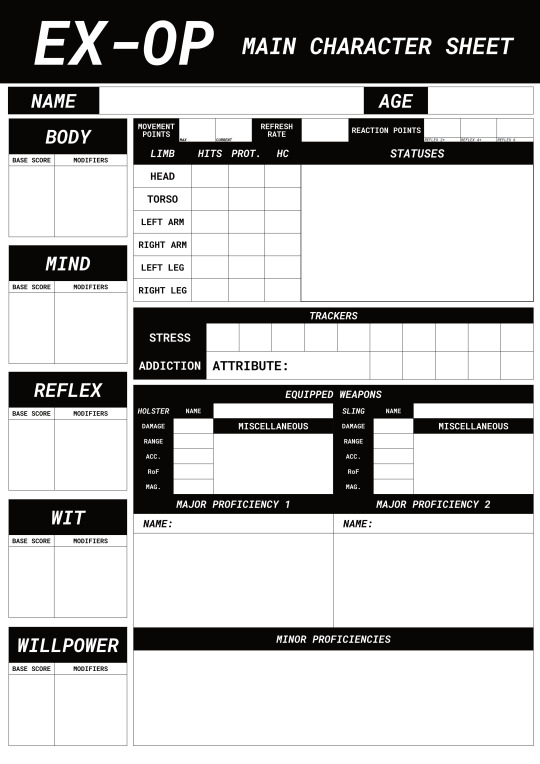
Now that I've posted some of the introductory lore for my TTRPG, EX-OP, I want to start breaking down some of the core player mechanics, as of course what better way is there to show you the game other than showing you what you'll be looking at for most of the time?
Name and Age are self explanatory, with the caveat that the life expectancy in an NAT urban center has fallen to an average of 45. Some may live longer, lots will live shorter. This is due to both social (read, getting shot at), and ecological conditions (read, breathing more smog than air).
The first mechanic I want to break down are ATTRIBUTES. Attributes are located on the left hand side of the character sheet, and describe in broad strokes, your expo's physical and mental abilities. They go up to a maximum of six, with 1 granting a -3 to all related rolls and 6 granting a +3 to all related rolls. As for what they mean, here's a brief description of each.
BODY: Your physical resilience and power. Determines how much you can carry (Encumbrance), how proficient you are with large or heavy guns, and your efficacy with blunt melee weapons. Also very effective for intimidation or other types of strongarming.
MIND: Your capacity for logic, reason, and intuition. Helps mostly for gathering concrete information, or giving medical aid to someone. Can also be used for deception, manipulation, debate and any number of interpersonal things.
REFLEX: Your reaction speed, your ability to move swiftly and silently, and your ability to handle weapons that require a little finesse, like handguns and swords. Most helpful for gunslingers, street samurai, freerunners, and anyone who needs to haul and/or wreck ass with utmost efficiency.
WIT: Your charisma, your people skills. Determines how well you can integrate into a social environment, familiar or unfamiliar. Expos with high WIT make friends easy and enemies easier. They can talk their way out of dangerous scenarios, or at the very least posture well enough to make said scenario easier. Also indicates your "street smarts", or more precisely, your ability to gather circumstantial or subjective information.
WILLPOWER: Your inner core, your soul. Having high WILLPOWER means you have unshakable convictions, and an unprecedented ability to persevere. It determines your ability to resist injuries, or combat Statuses in general. Your will can manifest in a number of different ways, equally befitting a stone cold veteran merc who's seen it all and lived to tell about it, or a deeply spiritual fresh expo who truly believes the divines will guide and protect them
However, the true benefit of what Attributes you choose are in what PROFICIENCIES your expo will be most conducive to. Proficiencies are located on the right hand side of the page, near the middle. Proficiencies are a blend of what would be classes/archetypes/vocations/etc and levels in a more traditional TTRPG. They're also the primary form of progression in EX-OP. Proficiencies are free form, categorized into two types- Major and Minor- and three subtypes- Combat, Roleplay, and Utility.
Major Proficiencies are your main skills, the things that make up the bulk of your character's skillset. They level from 1 at minimum and 5 at maximum. You have things like CYBERCOWBOY and NEOSHINOBI on the Combat end. On the Roleplay end you have Proficiencies such as AUTHORITARIAN and ANARCHO-CAPITALIST, and on the Utility end you have things like MEDICAL and COVERT HACKING. You get to have two Major Proficiencies, each of a different type, that you select when you make your character initially. So you can pick either a Combat and a Roleplay Major Proficiency, or a Utility and a Roleplay, or a Utility and a Combat.
Major Proficiencies also have Governing Attributes. The Governing Attribute of a Major Proficiency determines what level they start at when initially selecting them, to a maximum of level 3, based on your score in that Attribute. So, selecting Cybercowboy, which has the Governing Attribute of REFLEX, with a REFLEX score of 5 means you start at level 3 in that Major Proficiency. If you have a 2 in REFLEX, you'd start at level 2.
Minor Proficiencies are where the system opens up. You can have any number of Minor Proficiencies, which are purchased with Proficiency Points. You start with 5 Proficiency Points when making a character, which can be spent on both purchasing Minor Proficiencies, which begin at level 1, or purchasing additional levels in Minor Proficiencies. Additionally, you gain 2 Proficiency Points by default at the end of every "Job", or the full adventure that has been planned out.
Minor Proficiencies are more broad, encompassing your specific knack for things like Small Guns, Light or Heavy Armor, or Melee. Your Minor Roleplay Proficiencies could be things like Seduction, Eavesdropping, or Debate Lord. Minor Utility Proficiencies could be things like Security, Parkour, or Lockcracking. Minor Combat Proficiencies could be things like Sniping, Spray n' Pray, or First Aid.
Attributes and Proficiencies allow you complete freedom when creating a character, without the need to lock yourself into restrictive archetypes or progression paths. Progression in EX-OP is player driven and free form, designed to give concrete rewards at a very consistent rate. After all, any job could be your last, so reward is in order for surviving in the first place. You could be a sniping sweet talker, a combat master with a pension for cybersecurity, an unstable combat medic who arguably enjoys causing the injuries more than healing them, a lovable gunslinging ne'er-do-well, a refined corporat power broker who lives off of manipulation and domination, a strung out transhumanist who LOVES shotguns, a pyromaniac ex-corpmerc who was kicked off the force for the constant human rights violations. The possibilities are almost endless.
EX-OP: NAT Kickstarter launches April 20th!
#ttrpg#table top rpg#ttrpg design#roleplaying games#rpg#tabletop#tabletop games#table top games#story games#collaborative storytelling#table top role playing game#lore#ttrpg lore#cyberpunk#writing#creative writing#ttrpg mechanics#character sheet#character creation
0 notes
Text
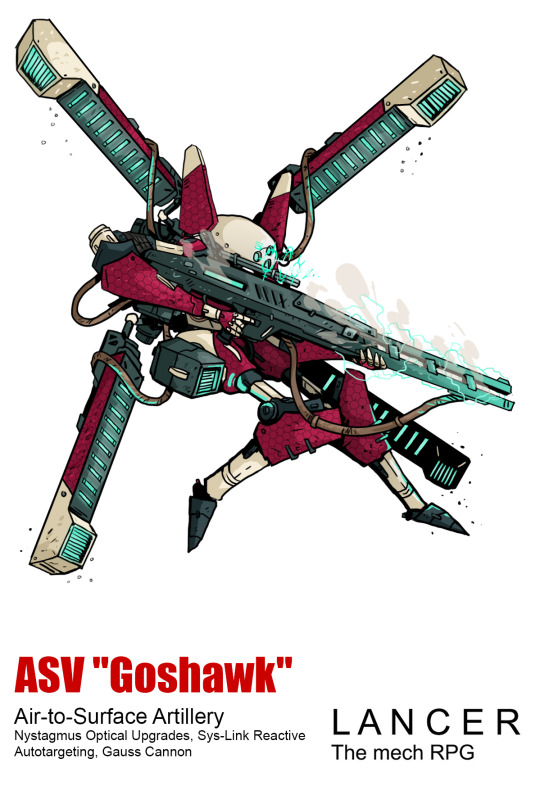
ASV "Goshawk"
Comm for a supplement in the work focused on flight mechs
#art#lancer rpg#lancer ttrpg#character design#mech#mecha#lancer#scifi#my art#sniper#satelite#mechanical#robot
419 notes
·
View notes
Text
the notion in video game culture that gameplay and story are separate is one that i think speaks to the juvenile state of the medium - mechanics and experience convey narrative themselves. it's the equivalent to lazy dubbed-over monologues or exposition titlecards in film, in regards to the notion that 'meaning' is something that can be slapped onto a work post-hoc like a sticker, rather than something integral to the entire thing. that's what causes the feeling of dissonance between the two - imagine if film audiences constantly said they dislike 'story' in films, while referring solely to an epidemic of infodumping interstitial cards and blade-runner-style phoned-in explanations of character motivation
349 notes
·
View notes
Text
When I was first building my Balor in Lancer, a big thing I was contending with was HOW SLOW THESE BEES ARE. Balors are so dang slow, but I was really struggling with fitting movement into my build because it disrupted many of my other plans.
Then my good good friend, our medic character's player, defended from the heavens with a note that said "I'm running Lancaster" and freed me from my worries so I could focus on being a big painful bee-ful lump of awful. Thank space mech God for Lancasters and the permanent umbilical cord that is the winch system. I point on the map and say "mother I wish to play with them over there" and she says "buckle up baby bee boy" AND LAUNCHES ME 7-8 HEXES ACROSS THE MAP YIPPEE.
But that's not all. My good friend and I came to a realization, after she picked up Fomorian, that we could give back to our community. Through the power of Houseguard 2 and Bonded 1, so long as we are winched together we give each other +2 to our saves and checks and are a max 11 hex wall of hard cover. Needless to say our Calliban, tiny fierce son, will never be messed with. No bullying allowed.
#lancer#lancer rpg#lancer ttrpg#lancer mechanics#mechanics#lancer build#lancer Lancaster#Lancaster#balor#lancer balor#mech#mecha#mechs
308 notes
·
View notes
Text
sometimes I read a ttrpg and get caught in a loop of "wow there is a lot that's not working for me in this" + "it's so much effort to write a ttrpg, let alone publish one, who am I to criticize?"
but i think criticism is fair as long as you're discerning about it! Like "this isn't a choice I would make as a designer" vs "this isn't something I would enjoy running/playing" vs "you definitely should not have written this for ethical reasons" vs "you definitely should not have written this because it mechanically does not do what you want it to do"
and all those criticisms can coexist!
#ttrpg#indie ttrpg#genuinely though i think i'd rather read something bad than just bland#a lot of my criticism ends up being 'you didn't lean in hard enough'#whether that's about genre or mechanics or something else#anyway there's no disappointment greater than picking up a genre game and finding that the genre has been so watered down that it's barely#there#and also that the mechanics are basically dnd thrown into a blender
418 notes
·
View notes
Text
I'm still holding off on any serious judgment of Daggerheart beyond normal cautious optimism until a QSG or actual play comes out but from what little I know, the thing that I find most intriguing is that, while it has a mixed success mechanic, it also has a mixed failure mechanic, which is one of the gaps I find in a lot of indie ttrpgs.
Games like Blades in the Dark or Candela Obscura have complete successes on a 6, complete failures on 1-3, and mixed successes on 4-5, in which you do the thing you want but there's a drawback. PbtA has a similar setup. But from what it sounds like, Daggerheart has the following:
Same number on the Hope and Fear dice: critical success
High roll and the Hope die is higher: success
High roll and the Fear die is higher: mixed success (example given in the articles talking about it - you do get to run by and hit the enemy, but you do not avoid an attack of opportunity)
Low roll and the Fear die is higher: failure
Low roll and the Hope die is higher: mixed failure (an example wasn't given, so I can't be positive, but it sounds like this might be the opposite - you miss, but so does the enemy)
And to be clear in BitD and Candela, I think the high risk of failure makes sense because of the nature of the genres they're serving. Honestly, again, I suspect PbtA is fine for the original game and it's the endless hacks that do little for me. But as someone who by and large would rather play in ongoing heroic fantasy, where escalating failure is just frustrating, I'd like to see a system that has a more balanced way of resolving the dice.
#ttrpg mechanics#this is once again and i can't stress this enough the most speculative of all things
33 notes
·
View notes
Text
Following up on my earlier post!
Pandemic-inspired stats & damage mechanic for indie ttrpgs that just jumped into my head - expanded text below, please don't strain!

When you would Take Damage mark one box in the relevant stat. When testing a stat with 3 marks, do so with Disadvantage. When a stat already has 3 marks and would take another, it Explodes instead: mark one box in both adjacent stats. If this would cause a chain reaction, any stats that just Exploded do not Explode twice. Mark Stress for each Explosion. Note: it is therefore theoretically possible to mark 5 points of Stress at once due to a chain reaction (the Stress track has 6 checkboxes).
Each mark on the Stress track has a corresponding negative effect, with minor effects earlier on the track and more serious ones further along. If the Stress track is already full and you must Mark Stress, you are Taken Out in an appropriate way to the damage you received. If you are Taken Out with Might damage, Test Luck to avoid death. If you survive being Taken Out gain a permanent Scar (which give both + & - effects) in the stat for which you received the damage that Took You Out.
Take a Short Rest to clear any 3 marks from your stats. A Long Rest clears all marks from all stats. Clear Stress with Downtime Activities, starting from the end of the Stress track and working back towards the start. Minor Downtime Activites clear 1 Stress each.
#indie dev#indie ttrpg#ttrpg dev#ttrpg mechanics#game design#ttrpg design#ttrpg stats#ttrpg damage mechanics
43 notes
·
View notes
Photo


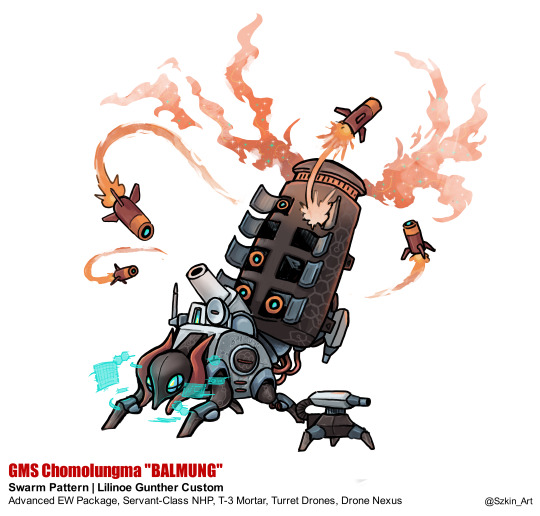
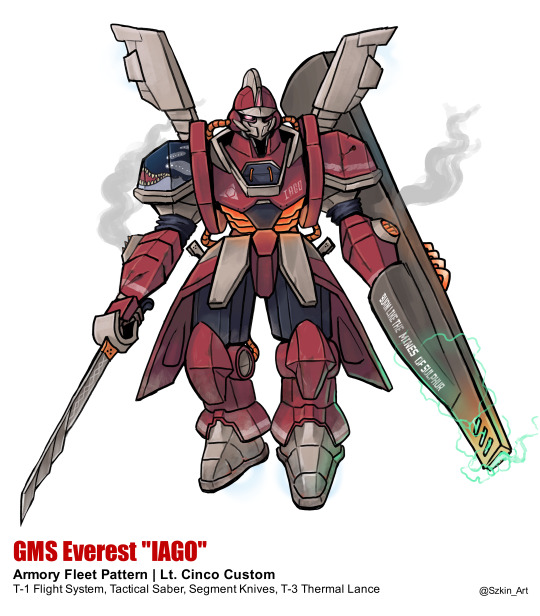

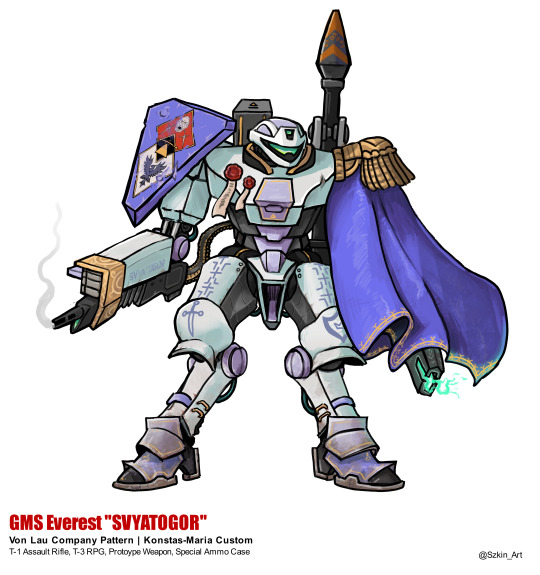
Finished lineup of Everests (and a Chomo) for my Lancer campaign, aaaaaaaaaa, this was a big project
#lancer rpg#Tabletop RPG#ttrpg#ttrpg character#mech#mecha#giant robot#mechanical design#gms everest#gms chomolungma#my art#artists on tumblr#digital art#illustration#scifi art
661 notes
·
View notes
Photo
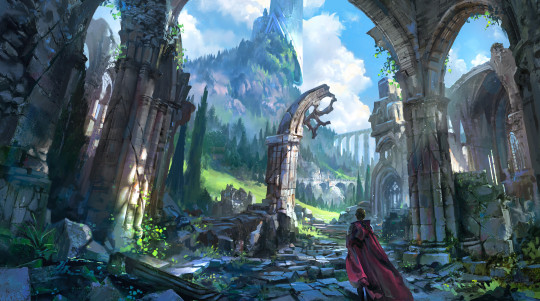
Drafting the Adventure: Dungeons Without Walls
I love the idea of dungeons, but there was a significant portion of my life as a DM where they didn’t feature in my games. While Pathfinder and 5e provided a great framework for character building and tactical skirmishes that I could build story on top of, neither was really great when it came time to detour into a dungeon. My players tended to get confused when we headed out to plunder the local ruin or cave system, spending a lot more time figuring out where they were and what they should be doing than actually doing anything.
The problem as it turned out was limited information. I had a picture of the dungeon in my head/notes but I couldn’t telepathically infer that to the party, and the back and forth questions where they tried to orient themselves within my mental labyrinth ate up a lot of session time prevented us from attaining that snappy pace that every table needs to keep the players invested.
Recently though I had an epiphany about overhauling exploration in d&d, and wrote up a whole post detailing how you could build and run wilderness adventures the same way you could a heist or a murder mystery. Because I was already writing a series about dungeon design it didn’t take long for me to realize that this exploration overhaul was 100% applicable, and could solve a lot of the delay and confusion my players usually faced on their next trip underground. Spoilers: it worked amazingly.
The key to this overhaul was giving my players enough information to see the dungeon as a sort of abstract checklist, and then giving them the power to investigate and check things off that list in whatever order they wished, when they enter a new level of the dungeon they get a new checklist to fill out which still keeps that sense of exploration. Folk love checking things off lists, and I as a dungeonmaster love it when players engage with the content I’ve spent so much energy creating even if it’s only poking their head in the door to realize they want to run away as fast as possible. Likewise, designing the dungeon this way let me tackle much larger concepts without having to sweat the details of filling up every little room as I would have to in map-centric design.
To summarize my exploration mechanic as It applies to dungeons:
During Design: After you’ve got the dungeons’ major concept, you divide it into unique “zones” (essentially what might be levels in a regular dungeon) with an interconnected theme, mechanic, or threat.
Each zone has a number of points of interest, which can be anything from trails to follow, odd sights they might investigate, to full complexes of rooms that you’ve mapped out. You don’t need to map out the points of interest otherwise, they sort of float abstractly within the zone
When players enter a zone, they become aware of its name and general descriptor, as well as how many total points of interest are in that zone. They also become aware of some points of interest immediately to serve as landmarks and give them a direction for their exploration, but most remain undiscovered until they venture off the path and start checking out their surroundings. Hidden among these points of interest are the doors that lead to zones deeper within the dungeon, encouraging the party to explore in order to progress.
During Play: When the players enter the dungeon, one player is appointed as the surveyor, who’s job it is to keep track of the zones, fill out that checklist, and check things off when the DM tells them that they’ve fully explored a point of interest.
Rather than needing to be aware of the exact room layout, the party just need to know what zone they’re in and what options are available to them, Because this information is delivered in the form of a checklist with empty spaces, the party know exactly how much of the dungeon they’ve explored, what’s left to explore, and when they’ve cleared out an area.
Lets take the image above as inspiration. Say the party is trying to make it up to the tower, you can easily see a progression of zones and maybe imagine a few to go alongside them:
Ruins & Foothills: The first area, filled with the remnants of an ancient civilization. Picked over by looters and now a home to all sorts of wildlife,
Mountainside: The obvious next goal, but locked off behind a challenging climb, Filled with hazards that threaten to knock the party back down to the foothills if they’re not careful
Caverns: Secret area accessible only if the party explore a cave on the mountainside, or make a beeline towards the old aqueduct landmark in the foothills, realizing it might be easier than the climb.
Spire Foundations: The door connecting to the foothills is guarded by a complex puzzle and arcane ward, but the party might be able to sneak in through the caves where erosion has caused a breakthrough into the cellars.
Spire Peak: High among the clouds, the party’s prize is somewhere here. Access to the upper sections of the tower are guarded by a territorial sphinx under arcane compulsion, though the party might just be able to skip that fight if they figure out the riddle to make the portal mirrors work in the foundations.
Trying to design all this by pencilling it in on a gridmap would take weeks, to say nothing of the headache it’d cause you trying to make things fit together and fill up empty space with content. Designing it first as a sequence of zones and then filling those out with interesting fights, puzzles, and encounters is the work of an afternoon or two. Likewise, its easy on your players: five zones with six to ten points of interest is far easier to tackle when you can make a checklist and see how much progress you’ve made, despite the fact that the area they’re exploring is quite vast.
I hope you find this as useful as I have, and if you need a more concrete example of how it might work, don’t worry, I’ll have one of those for you in the coming days.
#dungeon design#dnd#dungeons and dragons#d&d#5e#dm advice#dm tip#dm tips#dm tools#writing advice#pathfinder#ttrpg#homebrew#5e homebrew#homebrew mechanic#exploration
611 notes
·
View notes
Text
me, a fan of The Mechanisms, and a lover of High Noon Over Camelot, cracking open the Astral Adventuring guide for DnD and learning what the hell a Spelljammer is for the first time
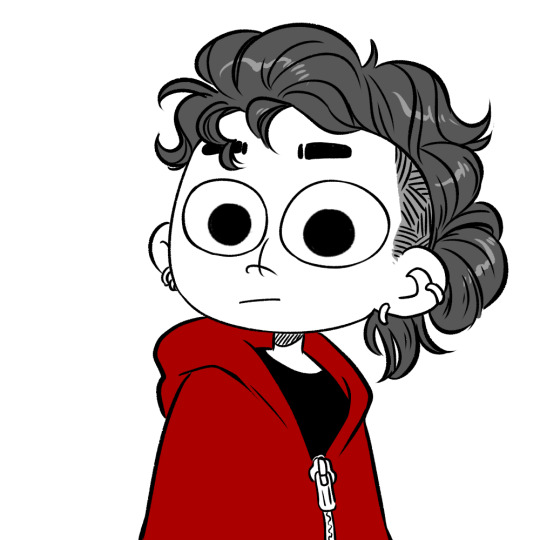

For those who don’t know:

780 notes
·
View notes